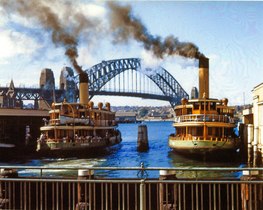 Kosciusko as a steamer approaches Circular Quay | |
| History | |
|---|---|
| Name | Kosciusko |
| Operator | |
| Builder | David Drake |
| Cost | £12,617. [1] |
| Launched | 1911 |
| Out of service | 1975 |
| Fate | Burnt out 1986 in Hobart |
| General characteristics | |
| Tonnage | 165 |
| Length | 34.1m |
| Speed | 10 knots (Kosciusko) |
| Capacity | 790 passengers approx. |
Kosciusko was a "K-class" ferry on Sydney Harbour. Launched in 1911, the timber-hulled steamer was built for Sydney Ferries Limited during the boom in cross-harbour ferry travel prior to the opening of the Sydney Harbour Bridge.
Contents
- Background
- Design and construction
- Service history
- Incidents
- Timeline
- See also
- References
- Further reading
- External links
Kosciusko was converted to diesel propulsion in the 1950s and served on Sydney Harbour until 1975 when she was sent to Hobart to assist following the collapse of the Tasman bridge. She was burnt out in 1982.









